How to Get Rid Of Chipmunks
43 min read Updated for October, 2019
Known for their small size and endearing chirp, chipmunks are rarely considered a threat. However, these sweet-looking animals can cause a surprising amount of damage to gardens and buildings, due to their foraging and burrowing behaviors. If you find chipmunk around your property, here are a few things to do to prevent them from entering the home and what to do if you capture one.
43 min read Updated for October, 2019
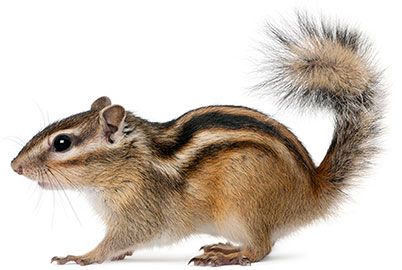
Chipmunk Sounds
Chipmunks use a variety of sounds to communicate, although the most frequent—a high-pitched chirp sound—is often mistaken for a birdsong. They also emit a deep clicking sound, which alerts other chipmunks to danger.
Chipmunk Tracks
Chipmunk tracks are difficult to locate as their feet are so small, but like most rodents they have four toes on their front paws and five toes on their bigger hindquarters. They tend to hop and bound as they travel which leaves a gallop pattern to their prints, with their hind paws landing before their front tracks.
Chipmunk Poop
Chipmunk poop is slightly larger than that of mice; dark, small and elongated with pointed ends, their poop range in size from half an inch to three-quarters of an inch. However, you rarely come across their droppings because chipmunks actually build special latrine chambers in their burrows to dispose of waste.
Identify
Chipmunks are reasonably easy to identify due to their distinctive stripes, although they’re sometimes confused with their close relative the squirrel. However, knowing the typical size, behavioral patterns, and markings of the chipmunk can help you distinguish it from other small rodents.
Physical Characteristics
Chipmunks are smaller than squirrels, weighing between two and five ounces and only reaching five to six inches in body length (not including the tail) depending on species. They easily recognizable by the five vertical black stripes on their backs, and the two white stripes on their faces. Beyond these general characteristics, it can be helpful to know the variations of chipmunk species.
Common Species
The most common chipmunk species are not all that different from one another, but they do have some distinct characteristics. Identifying which kind you’ve encountered on your property can help you create a game plan for removal if they become a nuisance.
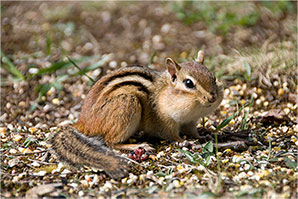
Eastern Chipmunk
The Eastern chipmunk is a very most common species of chipmunk found in North America. They cover a vast territory, from the Southeastern U.S. to parts of Canada.
Appearance
- Two to four ounces
- Up to 10 inches in length including tail
- Black stripes are separated by white stripes
- Stripes do not extend to tail, which is typically dark
- Four toes on front feet; five toes on hind feet
Behavior
- Proficient foragers; eat mushrooms, bulbs, fruits, seeds, plants, and bird eggs
- Active during the day, especially in early morning and late afternoon
- Adept at climbing, but prefer to forage for food on the ground
- Live and store food in long underground tunnels
- Hide tunnels by moving dirt away from digging spot with cheek pouches
- Do not hibernate but becomes less active during cold months
Habitat
- Prefer mature hardwood forests, mainly when there is ground cover available, like shrubs or rocks
- Can also be found in suburban and rural areas
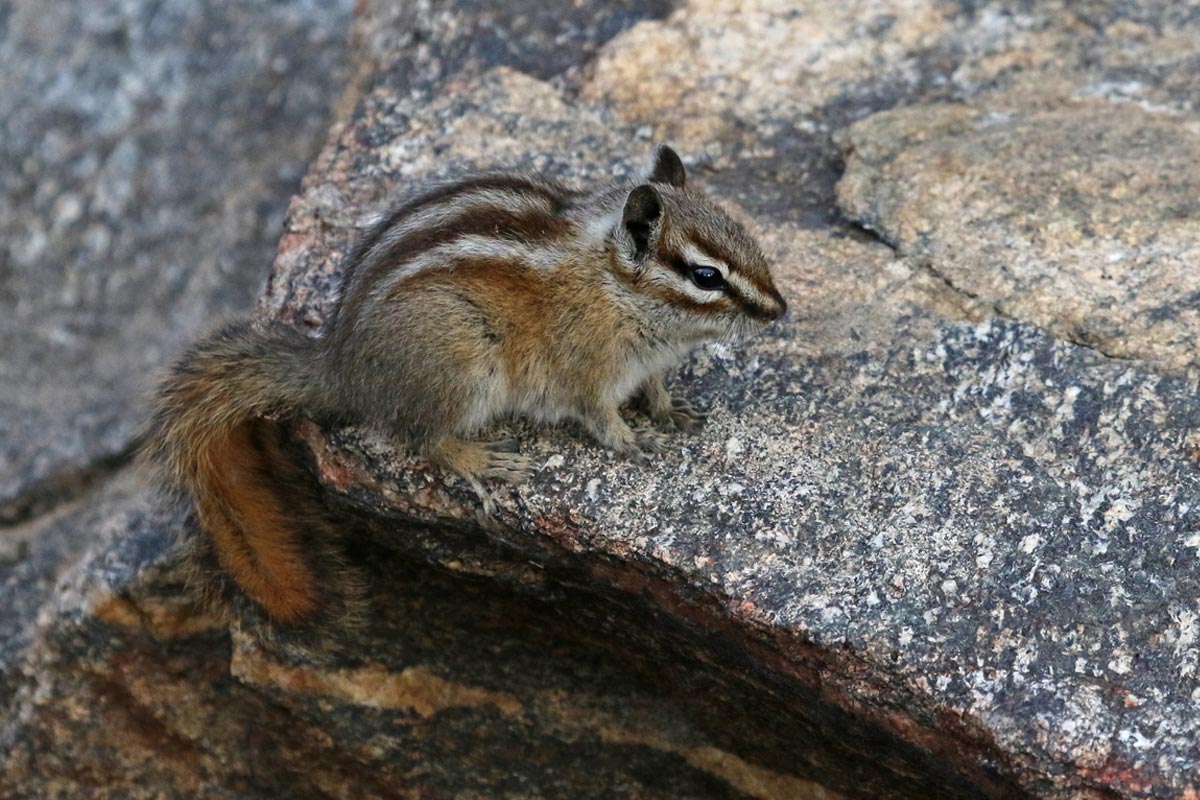
Least Chipmunk
Just like their name implies, least chipmunks are smaller than their cousin the Eastern chipmunk. They occupy more of Western North America and can be found as far North as western Canada.
Appearance
- Smaller of the chipmunk species, usually reaching no more than 10 inches in length and two ounces in weight
- Feature five black stripes, separated by lighter cream-colored stripes, on their backs, plus two lighter stripes on their faces face
- Unlike in the Eastern chipmunk, their stripes run all the way to the tail
Behavior
- Active during the day
- More submissive than larger chipmunks, but can still act territorial around their food caches
- Can survive when resources are scarce due to their small size and ability to survive on small amounts of food
- Better climber than the Eastern chipmunk and may build nests above ground, although they still burrow underground during the winter
- Eat a diet of nuts, berries, fruits, bulbs, insects, snails, and mushrooms
- Typically prefer a less wooded climate than the Eastern chipmunk; may live in rocky areas or forest openings
- More likely to make a nest in trees, logs, or shrubs
Treating Your Property For Chipmunks
If your prevention methods have failed and you’re already facing a chipmunk problem, there are still some low-risk actions you can take to treat the problem. These tactics won’t involve capturing and transferring the animals yourself, which is good news since it eliminates the risk of exposing yourself to disease.
Treatment methods include using spray repellents, granular repellents, and even sound pollution devices. Repellents typically either play on a chipmunk’s taste aversions—by using spices they dislike—or a chipmunk’s fear, by using urine scents from their most common predators. Sound devices, on the other hand, emit unpleasant noises at a frequency that humans can’t hear, frustrating the animals until they leave. Here are a few examples of treatment products to try.
DIY Treatments
If you prefer to use DIY products when defending your house against chipmunks, there is a range of options available to you. These home remedies may be cheaper and gentler on your garden than their store-bought competitors. If you're looking for a DIY solution, consider these homemade chipmunk repellents.
Garlic
Chipmunks detest the taste and smell of garlic, which is a good thing for homeowners since it's cheap and easy to come by. Try adding diced garlic to a spray bottle full of water and then apply to your garden.
Hot spices
Chipmunks dislike spicy foods like hot peppers, so try adding some cayenne or chili pepper from your spice rack to a water-based solution and then spray around your home or garden.
Mothballs
They may be standing guard over your sweaters, but these small pellets can also protect your garden. Place them around your yard and garden to discourage chipmunks from grazing.
Note: mothballs can be poisonous to humans, so make sure you keep them away from your food and water supplies, plus any plants you plan to eat.
Epsom salts and soap
When diluted with water, this can serve as an excellent and inexpensive chipmunk repellent
Chipmunks are attracted to yards and parks that have objects they can hide under, as well as food to eat.
Common Locations
Chipmunks can thrive in many different climates provided they can find the right resources. This can include forests, woodlands, plains, and even rocky terrain. These adaptable creatures can also make homes in more developed areas like city parks and suburban neighborhoods as long as they can find food, a water source, and adequate cover while foraging.
Chipmunks usually occupy a territory of about a quarter of an acre, and there are typically two to four chipmunks per acre, although sometimes populations are denser due to an abundance of food in a specific area.
Like other animals, chipmunks are attracted to yards and parks that have objects they can hide under, as well as food to eat. You may see more of these animals if you have stumps, logs, shrubs, or other covers that they deem suitable for hiding. If you have chipmunks living near your home, though, there’s a high chance you haven’t noticed them.
These small creatures are remarkably stealthy. When building a burrow, they relocate excess soil so that it doesn’t give away the location of their home (unlike moles, for example, who leave dirt mounds). They’re also adept at camouflaging the entrances to their burrows using leaves, sticks, and dirt. While they may be almost invisible to the human eye, these underground tunnels can be as long as 30 feet, with areas for hiding, hoarding food, and caring for young.
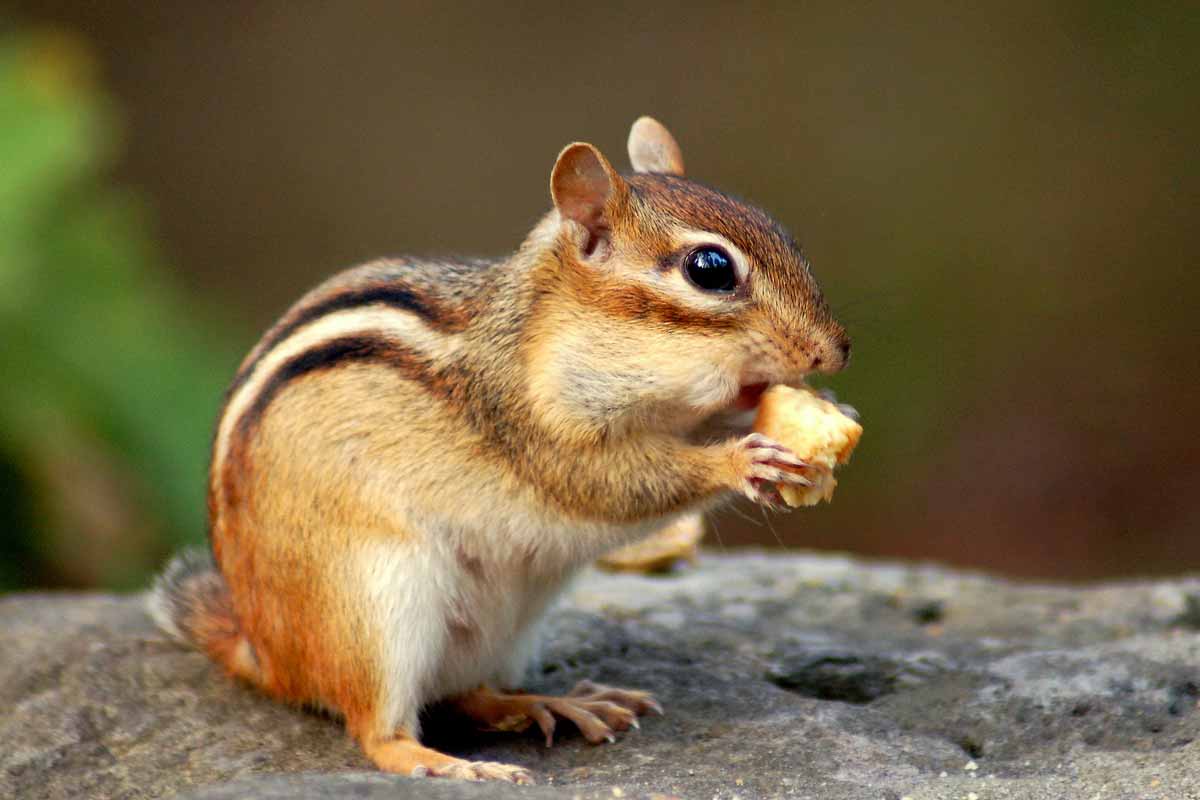
Your home may also be at higher risk if you have shrubs, bushes, or debris adjacent to the exterior.
Why They’re There
If you see chipmunks around your home, it’s likely because your property has resources they need.
Cover
Chipmunks must protect themselves from a wide range of predators, including owls, raccoons, coyotes, foxes, hawks, and even household pets. When they’re foraging, they need to be able to hide quickly. A landscape with lots of cover—like stumps, brush piles, plants, etc.—can provide this for them. Even though they traditionally find this cover in the wild, suburban or lightly wooded areas can also become attractive if they offer enough protection.
Your home may also be at higher risk if you have shrubs, bushes, or debris adjacent to the exterior. This cover makes it easier for chipmunks to stay concealed and burrow without being noticed.
Water
Because water is something that chipmunks can’t hoard, they’ll seek out areas where water is easy to access. If you have a water source near your home, like a creek or river, you’re more likely to see chipmunks living on your land.
Food
Chipmunks eat a variety of food, including berries, seeds, nuts, small insects, snails, mushrooms, and plant bulbs. Their special cheek pouches give them the advantage of carrying their food from place to place, which makes it possible for chipmunks to store food for the colder months when they’re far less active.
Since chipmunks don’t store fat in their bodies well and don’t hibernate, but instead enter a state called “torpor,” they need to eat during the winter occasionally. Their strong need to hoard makes them likely to frequent yards and parks with plentiful food, particularly if it’s the less perishable varieties, like nuts and seeds. If you have a garden with fruits, nuts, and seeds, your property may be a desirable home for chipmunks.
Chipmunk Sounds
Chipmunks use a variety of sounds to communicate, although the most frequent—a high-pitched chirp sound—is often mistaken for a birdsong. They also emit a deep clicking sound, which alerts other chipmunks to danger.
Chipmunk Tracks
Chipmunk tracks are difficult to locate as their feet are so small, but like most rodents they have four toes on their front paws and five toes on their bigger hindquarters. They tend to hop and bound as they travel which leaves a gallop pattern to their prints, with their hind paws landing before their front tracks.
Chipmunk Poop
Chipmunk poop is slightly larger than that of mice; dark, small and elongated with pointed ends, their poop range in size from half an inch to three-quarters of an inch. However, you rarely come across their droppings because chipmunks actually build special latrine chambers in their burrows to dispose of waste.
Inspect
Chipmunks can help promote a healthy ecosystem by distributing seeds when they hoard food. However, they can create problems if they choose to dig their food caches under homes, causing structural problems. They can also devastate gardens if they find plants that they like to eat.
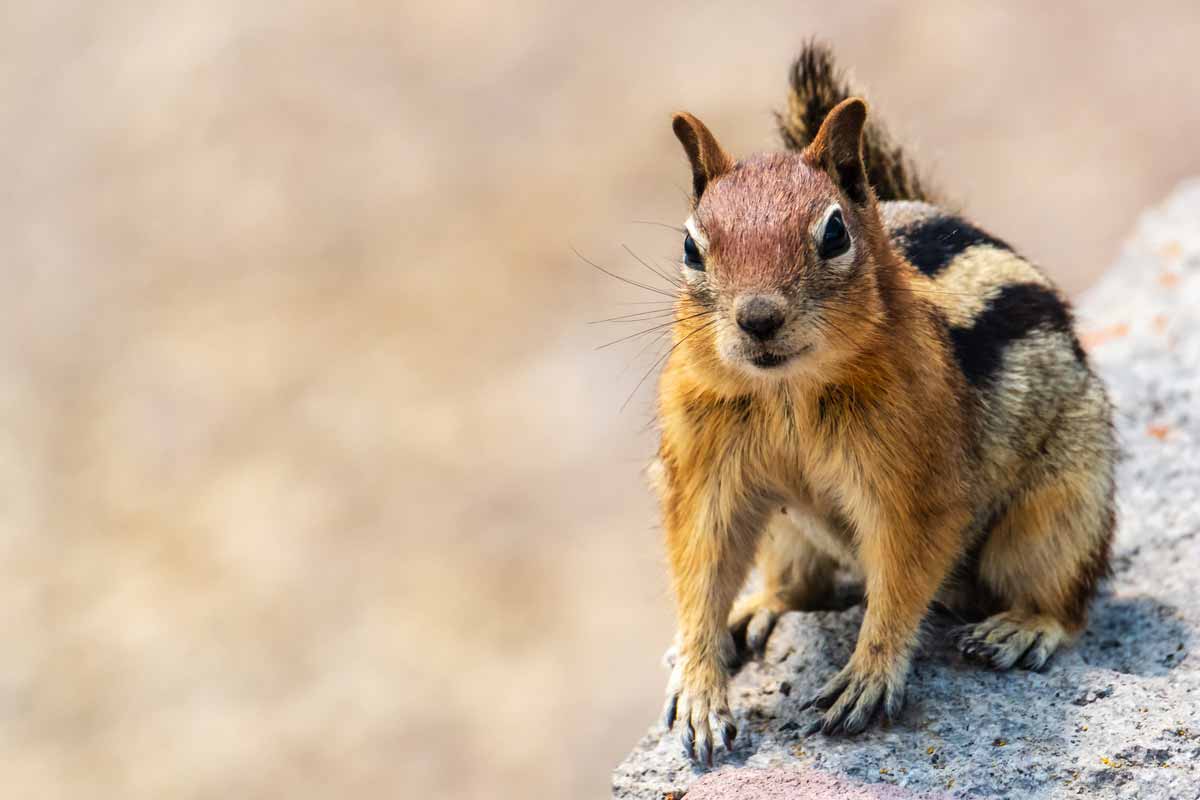
Should I Relocate This Animal?
Chipmunks are not protected under federal law, although some states may have regulations protecting these non-game critters. Always check with your local government before moving or harming a chipmunk.
If you have found chipmunks on your property and are considering getting rid of them, always weigh the pros and cons. Chipmunks may help plant trees and other plants when they relocate seeds, and they may help control insect populations as well.
What’s more, your chipmunk problem might be resolved by merely excluding the animals from your home or garden. This is a less risky, less expensive option that relocating the chipmunks.
However, if chipmunks have begun to invade your property, decimate your garden, or threaten structural damage, it may be time to take more serious action.
Gather The Tools You’ll Need
Leather gloves
Protects your hands if you come into contact with a frightened chipmunk
A live-catch trap
Helps to ensure the chipmunk doesn’t escape before you can relocate it. Consider a common snap trap or a wire mesh trap, which will prevent chipmunks from chewing their way out.
Bait
Lures the chipmunk into the trap. Kinds of nut butter, seeds, or raisins should work well.
Tarp
Protects your vehicle from animal waste during transport.
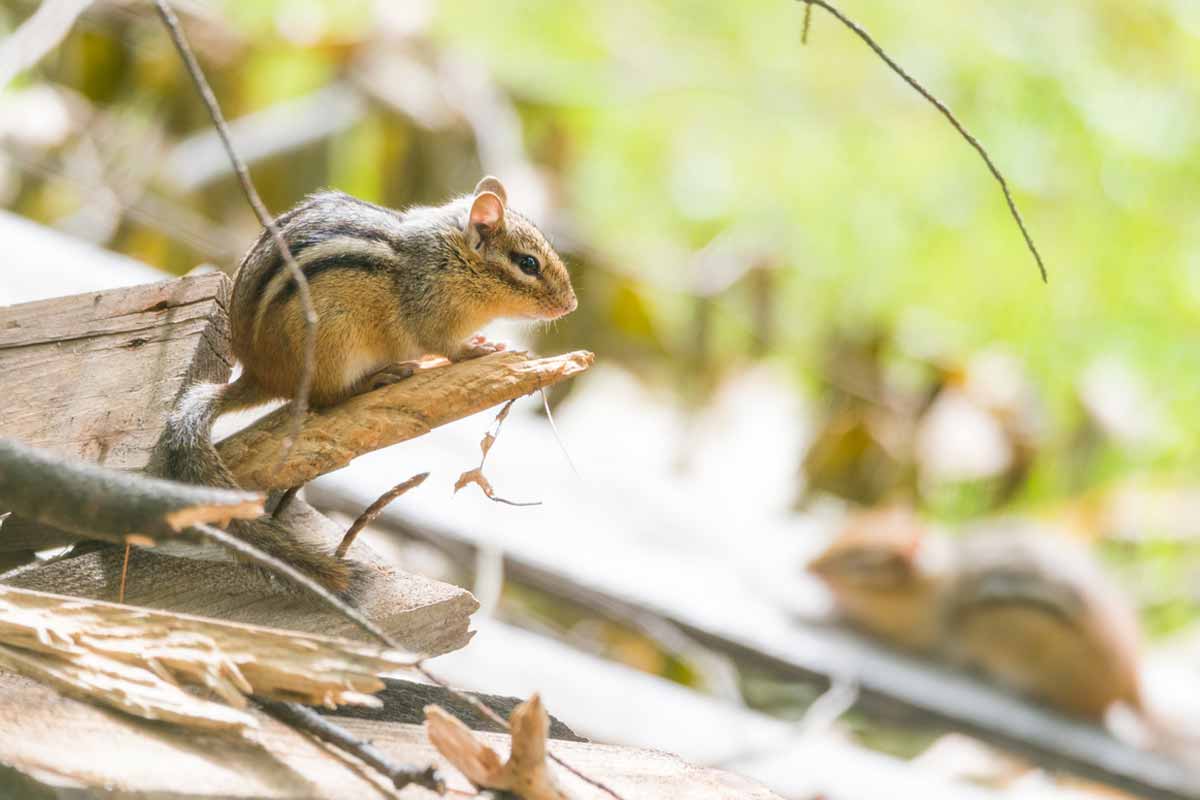
Treating Your Property For Chipmunks
If your prevention methods have failed and you’re already facing a chipmunk problem, there are still some low-risk actions you can take to treat the problem. These tactics won’t involve capturing and transferring the animals yourself, which is good news since it eliminates the risk of exposing yourself to disease.
Treatment methods include using spray repellents, granular repellents, and even sound pollution devices. Repellents typically either play on a chipmunk’s taste aversions—by using spices they dislike—or a chipmunk’s fear, by using urine scents from their most common predators. Sound devices, on the other hand, emit unpleasant noises at a frequency that humans can’t hear, frustrating the animals until they leave. Here are a few examples of treatment products to try.
DIY Treatments
If you prefer to use DIY products when defending your house against chipmunks, there is a range of options available to you. These home remedies may be cheaper and gentler on your garden than their store-bought competitors. If you're looking for a DIY solution, consider these homemade chipmunk repellents.
Garlic
Chipmunks detest the taste and smell of garlic, which is a good thing for homeowners since it's cheap and easy to come by. Try adding diced garlic to a spray bottle full of water and then apply to your garden.
Hot spices
Chipmunks dislike spicy foods like hot peppers, so try adding some cayenne or chili pepper from your spice rack to a water-based solution and then spray around your home or garden.
Mothballs
They may be standing guard over your sweaters, but these small pellets can also protect your garden. Place them around your yard and garden to discourage chipmunks from grazing.
Note: mothballs can be poisonous to humans, so make sure you keep them away from your food and water supplies, plus any plants you plan to eat.
Epsom salts and soap
When diluted with water, this can serve as an excellent and inexpensive chipmunk repellent
Try not to lose sight of the invader as it makes its way out of the house.
How To Steps For DIY Removal
“What if a chipmunk’s in my house?”
If you’ve spotted a chipmunk in your house, don’t panic. Chipmunks are excellent at fleeing tricky situations and will already be on the hunt for an exit. The best thing you can do as a homeowner is simply back off and let the chipmunk find its way out.
Step 1: Try to limit the chipmunk to one area of your home. If you found it in the bedroom, for example, try to contain it in that room.
Step 2: Create an escape route. The chipmunk will probably already be looking for a way out, so try to help it along by opening a window or an exterior door.
Step 3: Wait for the chipmunk to leave. Try not to lose sight of the invader as it makes its way out of the house. You want to make sure it has exited and not just entered another area of your home.
Chipmunks are usually solitary creatures, but that doesn’t mean the burrow will be empty.
“What if a chipmunk’s burrowed under my house?”
Chipmunks dig small, discreet holes for their burrows, which can make them difficult to identify. If you’ve seen holes in the ground that are smooth at the edges and slightly larger than a silver dollar, you may have found a chipmunk hole. The good news is that chipmunks are active during the day, and you can confirm your suspicions by watching the hole while it’s daylight. If you’ve spotted chipmunks and the hole is near your sidewalk, driveway, or house foundation, you have reason to be concerned.
Most experts recommend live traps since they’re more humane and don’t present the risk of having chipmunks die under your home and cause a foul odor. Here’s how you can protect your home from structural damage if you’ve found a chipmunk infestation.
Step 1: Purchase and set a live trap over the chipmunk holes. Their burrows often have several emergency exits, so set traps on as many as you find.
Step 2: Bait the trap. Chipmunks aren’t picky. They typically like peanut butter, sunflower seeds, fruits, or even cereal. If you opt for peanut butter, you can always make it more enticing by sprinkling nuts or seeds on top.
Step 3: Wait. Chipmunks are most active during the mornings and afternoons but sleep at night just like humans.
Step 4: If you find a chipmunk in your trap, you’re in luck. You’ll now be able to transport the animal to a new location without harming it—but while safely ridding it from your property. Choose a place that is several miles away from your home and make sure you get permission from the landowner.
Step 5: Repeat. Chipmunks are usually solitary creatures, but that doesn’t mean the burrow will be empty. They also use their underground homes for mating and rearing their young, which means there may be others inside that will need to be trapped.
Step 6: If you’re confident you’ve removed all the chipmunks, you can now focus on preventing them from re-entering your home. This is called exclusion.

If you’ve found a chipmunk in your home, a thorough cleaning is in order after you remove the animal.
Risks Of Disease
Like many rodents, chipmunks can carry diseases that are transmittable to humans. This is one reason we recommend taking precautions when removing chipmunks from your property. Here are a few diseases chipmunks may carry:
Plague:
This disease can be contracted from handling an infected chipmunk or from the fleas they carry. Once a person is infected, the disease will attack the immune system and cause grave illness. The plague is treatable with antibiotics.
Leptospirosis:
This disease is spread through the urine of infected animals, often rodents. If a chipmunk or other infected rodent has accessed your food or water supply, you may be at risk of contracting this disease. If you’ve found a chipmunk in your home, a thorough cleaning is in order after you remove the animal. While dangerous if left untreated, leptospirosis typically responds well to antibiotics.
Salmonellosis:
Exposure to animal feces can cause this illness and can cause diarrhea and gastrointestinal distress in humans. While unpleasant, this infection typically goes away on its own within a few days. If a chipmunk has entered your home, make sure you disinfect your surfaces thoroughly, since bacteria from fecal matter can quickly spread through the air.
Chipmunk Sounds
Chipmunks use a variety of sounds to communicate, although the most frequent—a high-pitched chirp sound—is often mistaken for a birdsong. They also emit a deep clicking sound, which alerts other chipmunks to danger.
Chipmunk Tracks
Chipmunk tracks are difficult to locate as their feet are so small, but like most rodents they have four toes on their front paws and five toes on their bigger hindquarters. They tend to hop and bound as they travel which leaves a gallop pattern to their prints, with their hind paws landing before their front tracks.
Chipmunk Poop
Chipmunk poop is slightly larger than that of mice; dark, small and elongated with pointed ends, their poop range in size from half an inch to three-quarters of an inch. However, you rarely come across their droppings because chipmunks actually build special latrine chambers in their burrows to dispose of waste.
Prevent
As with most pest issues, prevention is the best and cheapest course of action. We recommend these methods to protect your home and garden.
Prevention Methods
Method 1: Protecting your garden
As harmless as they seem, chipmunks can wreak havoc on gardens, thanks to their love of fruits, seeds, and bulbs. Here are a few ideas to keep your garden safe from these scavengers:
- Plant bulbs beneath a mesh metal cloth to prevent chipmunks from digging up flowers
- Surround your garden (or entire yard) with a gravel border to reduce cover
- Use a natural repellent to spray plants like cayenne pepper, garlic, or diluted soap
- Relocate bird feeders so they’re far from the garden. Spilled seeds can attract chipmunks.
Make your yard less appealing to chipmunks by removing ground covers like woodpiles, leaf piles, stumps, or other debris
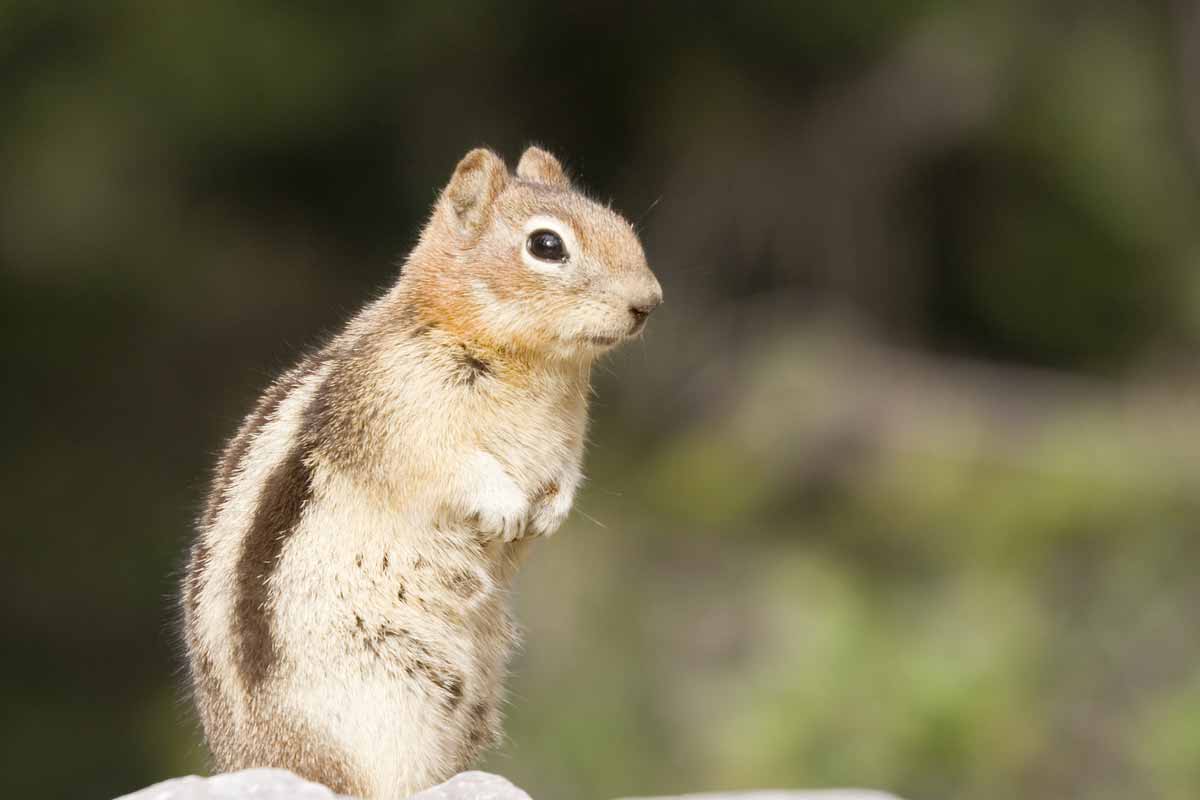
Method 2: Protecting your home
- Use mesh metal cloth to exclude chipmunks from any openings in your home
- Use caulk to fill any smaller holes that can be completely sealed
- Protect your home’s foundation by applying L-shaped footers that prevent burrowing
- Avoid planting shrubs or other plants against your home, which may help chipmunks stay concealed; chipmunks prefer to burrow in areas with cover
- Never leave pet food outside
Treating Your Property For Chipmunks
If your prevention methods have failed and you’re already facing a chipmunk problem, there are still some low-risk actions you can take to treat the problem. These tactics won’t involve capturing and transferring the animals yourself, which is good news since it eliminates the risk of exposing yourself to disease.
Treatment methods include using spray repellents, granular repellents, and even sound pollution devices. Repellents typically either play on a chipmunk’s taste aversions—by using spices they dislike—or a chipmunk’s fear, by using urine scents from their most common predators. Sound devices, on the other hand, emit unpleasant noises at a frequency that humans can’t hear, frustrating the animals until they leave. Here are a few examples of treatment products to try.
DIY Treatments
If you prefer to use DIY products when defending your house against chipmunks, there is a range of options available to you. These home remedies may be cheaper and gentler on your garden than their store-bought competitors. If you're looking for a DIY solution, consider these homemade chipmunk repellents.
Garlic
Chipmunks detest the taste and smell of garlic, which is a good thing for homeowners since it's cheap and easy to come by. Try adding diced garlic to a spray bottle full of water and then apply to your garden.
Hot spices
Chipmunks dislike spicy foods like hot peppers, so try adding some cayenne or chili pepper from your spice rack to a water-based solution and then spray around your home or garden.
Mothballs
They may be standing guard over your sweaters, but these small pellets can also protect your garden. Place them around your yard and garden to discourage chipmunks from grazing.
Note: mothballs can be poisonous to humans, so make sure you keep them away from your food and water supplies, plus any plants you plan to eat.
Epsom salts and soap
When diluted with water, this can serve as an excellent and inexpensive chipmunk repellent
Chipmunk Sounds
Chipmunks use a variety of sounds to communicate, although the most frequent—a high-pitched chirp sound—is often mistaken for a birdsong. They also emit a deep clicking sound, which alerts other chipmunks to danger.
Chipmunk Tracks
Chipmunk tracks are difficult to locate as their feet are so small, but like most rodents they have four toes on their front paws and five toes on their bigger hindquarters. They tend to hop and bound as they travel which leaves a gallop pattern to their prints, with their hind paws landing before their front tracks.
Chipmunk Poop
Chipmunk poop is slightly larger than that of mice; dark, small and elongated with pointed ends, their poop range in size from half an inch to three-quarters of an inch. However, you rarely come across their droppings because chipmunks actually build special latrine chambers in their burrows to dispose of waste.
When to Call a Professional
A determined homeowner alone can often remedy chipmunks on their own, but in some severe cases, a professional may need to be called in. If chipmunks have already damaged—or posed a major threat to—the foundation of your home, it’s probably best to skip the DIY solutions and call in an experienced exterminator. Similarly, if you and your family rely on the food you grow in your garden, chipmunks may become more than just a nuisance.
Remember, chipmunks are usually solitary creatures, and it’s unusual for more than four to live on the same acre of land. If you see many chipmunks, you may have a nest on your property: another reason to seek professional help sooner rather than later.
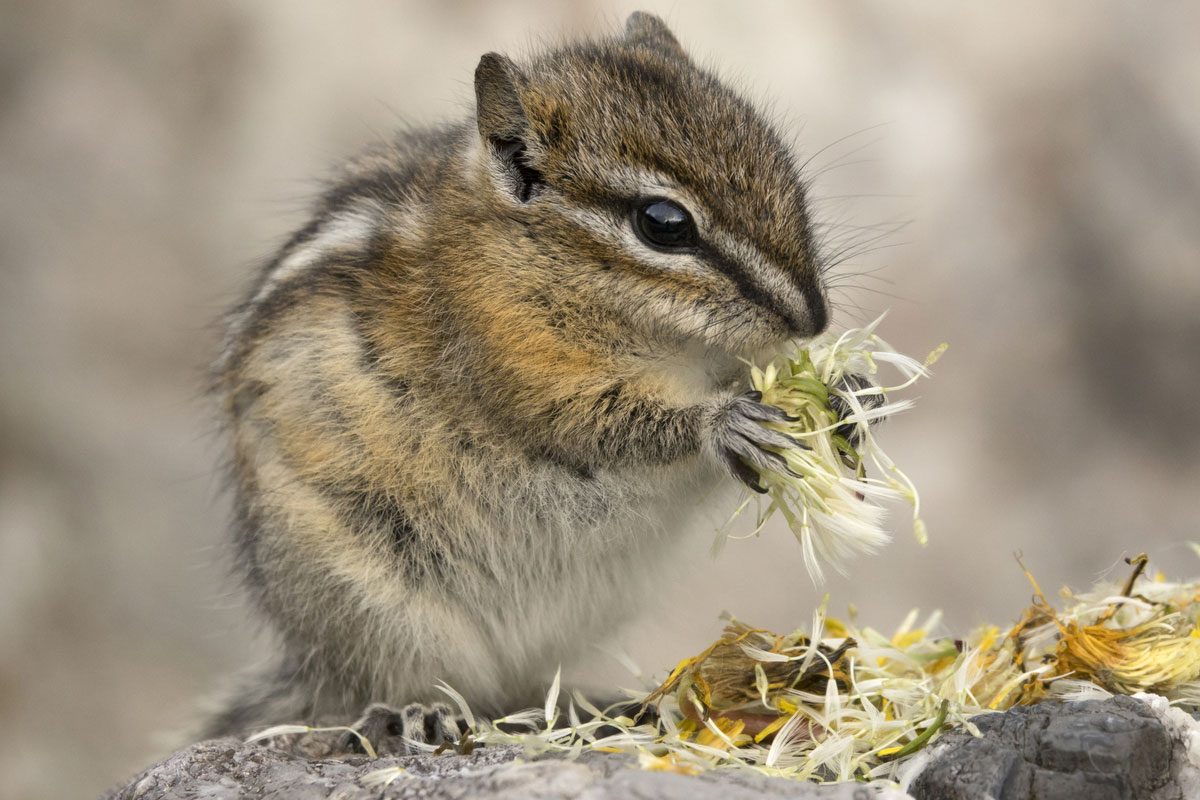
Sources
http://icwdm.org/Publications/pdf/Chipmunks/ADM-chipmunks2.pdf
https://animaldiversity.org/accounts/Tamias_striatus/
https://en.wikipedia.org/wiki/Eastern_chipmunk
https://animaldiversity.org/accounts/Tamias_minimus/
http://www.havahart.com/chipmunk-facts#habitat
http://icwdm.org/handbook/rodents/chipmunks.asp
http://icwdm.org/Inspection/GroundHoles.aspx
https://www.cdc.gov/rodents/diseases/direct.html
https://www.hgtv.com/outdoors/gardens/animals-and-wildlife/how-to-keep-chipmunks-out-of-the-garden
https://pss.uvm.edu/ppp/articles/chipmunks.html
Treating Your Property For Chipmunks
If your prevention methods have failed and you’re already facing a chipmunk problem, there are still some low-risk actions you can take to treat the problem. These tactics won’t involve capturing and transferring the animals yourself, which is good news since it eliminates the risk of exposing yourself to disease.
Treatment methods include using spray repellents, granular repellents, and even sound pollution devices. Repellents typically either play on a chipmunk’s taste aversions—by using spices they dislike—or a chipmunk’s fear, by using urine scents from their most common predators. Sound devices, on the other hand, emit unpleasant noises at a frequency that humans can’t hear, frustrating the animals until they leave. Here are a few examples of treatment products to try.
DIY Treatments
If you prefer to use DIY products when defending your house against chipmunks, there is a range of options available to you. These home remedies may be cheaper and gentler on your garden than their store-bought competitors. If you're looking for a DIY solution, consider these homemade chipmunk repellents.
Garlic
Chipmunks detest the taste and smell of garlic, which is a good thing for homeowners since it's cheap and easy to come by. Try adding diced garlic to a spray bottle full of water and then apply to your garden.
Hot spices
Chipmunks dislike spicy foods like hot peppers, so try adding some cayenne or chili pepper from your spice rack to a water-based solution and then spray around your home or garden.
Mothballs
They may be standing guard over your sweaters, but these small pellets can also protect your garden. Place them around your yard and garden to discourage chipmunks from grazing.
Note: mothballs can be poisonous to humans, so make sure you keep them away from your food and water supplies, plus any plants you plan to eat.
Epsom salts and soap
When diluted with water, this can serve as an excellent and inexpensive chipmunk repellent
Sources
https://www.crittercontrol.com/services/chipmunks/chipmunk-sounds
http://www.havahart.com/articles/interesting-chipmunk-facts
https://www.bear-tracker.com/chipmunk.html
Chipmunk Sounds
Chipmunks use a variety of sounds to communicate, although the most frequent—a high-pitched chirp sound—is often mistaken for a birdsong. They also emit a deep clicking sound, which alerts other chipmunks to danger.
Chipmunk Tracks
Chipmunk tracks are difficult to locate as their feet are so small, but like most rodents they have four toes on their front paws and five toes on their bigger hindquarters. They tend to hop and bound as they travel which leaves a gallop pattern to their prints, with their hind paws landing before their front tracks.
Chipmunk Poop
Chipmunk poop is slightly larger than that of mice; dark, small and elongated with pointed ends, their poop range in size from half an inch to three-quarters of an inch. However, you rarely come across their droppings because chipmunks actually build special latrine chambers in their burrows to dispose of waste.




